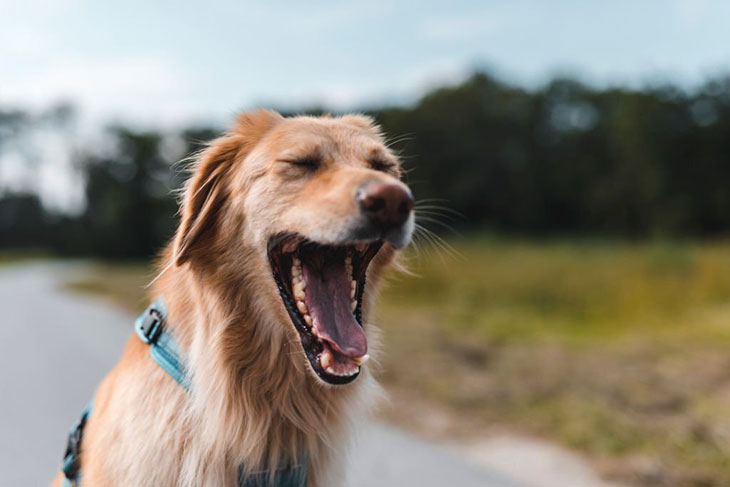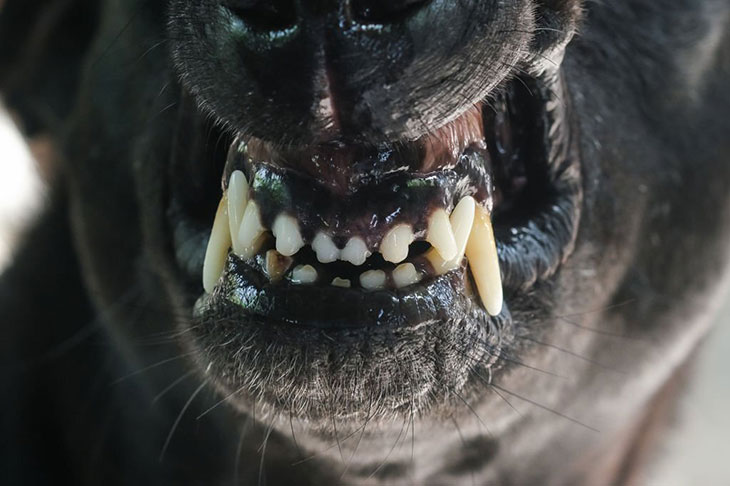You may notice that your dog chatters teeth after yawning, and this phenomenon may happen frequently.
This case can be considered a warning showing an issue with your dog’s health.
So, what are the reasons for the case in which a dog chatter teeth after yawning? I will list some leading causes and give solutions to prevent this behavior.
Dog Chatters Teeth After Yawning: What Are Reasons?

When the temperature becomes lower, your dog can have chattering teeth after yawning.
Additionally, anxiety, stress, pain, discomfort, and medical conditions are also one of the main causes of this issue.
Cold Temperature
When your dog shivers or has chattering teeth, the possible cause can be the chilly weather outside.
Temperature extremes can be dangerous for puppies and dogs with short coats.
Your pet only expresses some basic emotional needs, and dog chattering teeth after yawning is one of their ways.
The immune system activates to protect the body. The involuntary action is designed to create heat, which helps them feel more at ease.
In this case, the easiest thing to do is provide your dog with a warm blanket. Your dog may have a temperature if the condition continues.
Anxiety Or Stress
When your dog is either really happy or particularly sad, they may begin to express their feelings.
Then, anxiety and stress in dogs can be a genuine problem and expressed by chattering their teeth. This action can become a habit and happen when your pets feel sad or afraid.
If your dog is experiencing stress, you must look for and remove the source. There might be several things going on with your dog that are causing these negative emotions.
Dog anxiety may be harmful if it is neglected or in a long-term period.
Chronic stress from untreated anxiety may cause other behavioral disorders, anger, destructive behavior, and physical health concerns.
Pain Or Discomfort
When in discomfort, most dogs will make some kind of nose, which is sometimes exhibited by chattering.
A dog’s jaw chattering after yawning can be noticed clearly if there is dental pain.
You should take your dog to a vet when you see your dog chatters his teeth after yawning, along with some other symptoms of dental issues, including:
- Abnormal breath: Bad breath in dogs may indicate poor dental health
- Difficulties when eating: While they have trouble with their teeth, they usually swallow and dislike particular meals, which can cause oral pain.
- Changing the color of their gums: The dog’s gum can become red, puffy, or even bleed when they have serious dental problems. It also causes gum pain.
Medical Conditions
You need to take extra caution when your dog may suffer from the potentially fatal disorder of seizure disorders or other neurological issues.
It is not a toothache or achy joint.
The chattering of the teeth and other focal motor seizures are prevalent. This happens due to a global tightening of muscle fibers and causes the general body and jaw to tremble.
And stress-induced epileptic seizures usually occur in dogs. Some factors, such as stress, lack of sleep, the environment, and hormones, are most often cited.
Convulsions may happen to dogs of any breed.
Epilepsy also may produce severe seizures. A variety of causes may provoke the illness in dogs.
Some reasons, such as extremely bright light, startling loud noises, and other triggers, can cause this illness.
This commonly is along with facial twitching and respiratory problems. Besides, your dog may froth at the mouth.
The seizures caused by epilepsy may severely impair their quality of life. It is essential to take your vet to determine the cause of seizures to provide a suitable treatment.
The disease known as Parkinson’s is another example in dogs. This illness is relatively uncommon.
It develops when dopamine reserves are depleted over time. This harms the nerve cells.
Parkinson’s can manifest in wobbly gait, head trembling, and clenched. Insomnia, muscular stiffness, and leg tremor are the other most noticeable symptoms.
What Should You Do To Address This Behavior?

After knowing why your dog chattering teeth after yawning, I will give you some potential solutions to prevent this phenomenon.
Changing Temperature Of The Environment
There is no “dog-friendly” temperature. The preferences of many dog breeds vary. Therefore, overheating and hypothermia are readily apparent.
A dog’s natural reaction to the cold is to shiver and shield its nose. It will also try to find somewhere to take cover and keep warm.
When dogs get overheated, they pant to cool down. It is not necessarily a sign of discomfort when they are panting.
Just keep their body temperature steady, as it should be. When spring arrives, so do panting and heat exhaustion.
When they need to lose the most weight, make the transition, that’s when it happens.
Recognising And Managing Stress/Anxiety
Stress and anxiety in dogs may manifest in a variety of ways. To ensure the mental health of their dogs, pet owners should pay close attention to signs of anxiety, including:
- Excessive barking, particularly in new environments.
- When they are worried or agitated, they may pant intensely and pace back and forth.
- Destructive behavior can be seen. Some dogs deal with anxiety by digging, scrubbing, or chewing on household items, sandals, or other things.
- Shivering or shaking also are common signs.
- The worst symptom is freezing. It is a sign of submission during training. It harms dogs and pet owners if it freezes in a potentially dangerous scenario.
Resolve Pain/Discomfort
You ought to consult your veterinarian whenever your dog experiences any kind of discomfort. Please comply with your veterinarian’s advice after a visit.
You also should call the veterinarian again if any more symptoms occur and do this in particular cases if you notice adverse effects after taking pain medication.
Remember that all pain medication you give furry friends should be consulted with a veterinarian.
Provide Treatment For Medical Condition
All illnesses or injuries might cause anxiety in a pet. Understanding what’s wrong with your pet ensures their continued health and happiness.
Many medical issues are linked to chattering after yawning. Dental issues can be the most popular reason. Then, a trip to a vet is required to check your dental health.
It is also crucial to keep calm when your dog experiences neurological issues such as seizures or Parkinson’s and remove all possible dangers around them.
Your veterinarian can shed light on the root of the problem, provide suitable treatment, and advise how to keep your dog comfortable going forward.
FAQs

Should I Be Concerned If I Hear My Dog’s Teeth Chattering?
Yes, you should. Your dog’s jaw chattering after yawning may indicate excitement and fear of cold or severe problems.
It may not be a big deal if it occurs seldom and your dog appears good.
But If it happens frequently or is followed by other strange behaviors, you should contact a vet.
Why Do Old Dogs Chatter Their Teeth?
Old dogs may chatter their teeth because of dental difficulties, discomfort, or sensation changes. Teeth chattering may result from dental issues.
However, you must see a vet to find the root cause and protect your elderly dog.
Why Is My Dog Chattering His Teeth And Shaking?
While teeth chattering and shaking may be symptoms of discomfort, convulsions, or neurological disorder, other explanations exist.
Sometimes dogs chatter their teeth when chilly, anxious, or enthusiastic. Besides, strong smells also cause this in dogs.
Conclusion
All in all, various causes lead to the phenomenon in which a dog chatters teeth after yawning, including cold temperature, stress, pain, or even some serious medical conditions.
It is crucial to determine exactly why your dog chattering teeth after yawning to have proper solutions.
Because this might be innocuous or a symptom of the problem, you should pay attention to your dog’s signs and know when to take them to a vet.
